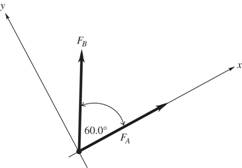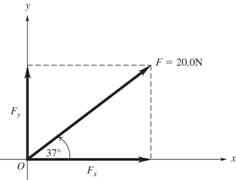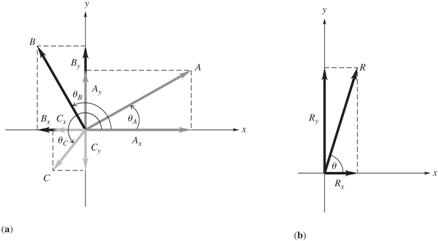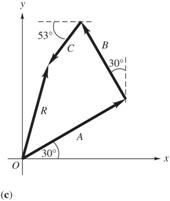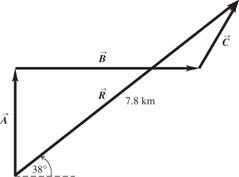|
ANSWERS |
||
| Quiz 1 - Chapter 4, 1 | ||
| CH 4 : Multiple Choice Questions-1, 2, 15 | ||
| exercises/problems -1, 2, 3, 5; If Ch. 4 problems seems difficult, skip to the Ch. 1 exercises/problems below then return to finish these later. | ||
| CH 1: exercises/problems-34, 37, 38 (see exercise #4, Ch 4) for comparison and practice), 42, 44, 48, 50 | ||
| DISCUSSIONS | ||
| CH. 4
Multiple Choice Questions 1, 2, 15 each deal with Newton's first Law, which says if the net force is ZERO, the object undergoes uniform motion or remains at rest. |
||
| exercises problems. | ||
| 1. Fx = 10*cos45 and Fy = - 10*sin 45 assuming the positive y directions is UP. | ||
|
2. Let the 270 N-force be along the positive x
axis, and the 300 N-force be 60 degrees above the positive x
axis. The components of the resultant are Rx
= 300*cos 60 + 270 and Ry = 300*sin60 + 0 = 300*sin 60.
Find the magnitude and angle using class notes.
Solve:
|
||
| 3. Fx = F*cos50 and Fy = F*sin 50 assuming the positive y directions is UP. | ||
| 4. The net force is vertically up with magnitude 5 = 2*T*sin 52.5. Solve for T = magnitude of tension force. | ||
| 5. Fx = 985*cos 31- 788*cos58 -
411*cos53 and Fy = 985*sin 31 + 788*sin58 - 411*sin53 Find the magnitude and angle using class notes. |
||
| CH. 1 | ||
| 34. (a) quadrant 1 (b) quadrant
3 (c) quadrant 2 (d) quadrant 4 Below is another way of seeing the problem: 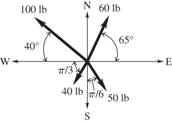 |
||
| 37. (a) The resultant is in the first
quadrant. (b) the difference is in the third quadrant. Use tail to tail method (c) the resultant is in the opposite direction as the vector in part (a). (d) the difference is in the opposite direction as the vector in part (b). Use tail to tail method. |
||
| 38. See hint to #4, Ch. 4. Same problem,
different numbers> Below is another way of seeing the problem: .  (b) Careful measurement of the length of |
||
| 42. Fx = 20*cos37 and Fy
= 20*sin 37
Below is another way of seeing the problem:
|
||
| 44. Starting with vector-A and going counter-clockwise:
Here are the x components: 12 cos 53, - 6cos60, 15cos40 . And here are the y components 12sin 53, -6sin 60, -15sin 40. Below is another way of seeing the problem: For each vector, use the relations
Solve: For
vector
For vector
|
||
| 48. Resolve the components as we did in problem
44. Add up the x-components to get Rx. Add up
the y components to get Ry. Use the
Pythagorean Theorem to get the magnitude. See class notes for the
quadrant and angle. Below is another way of seeing the problem: The
counterclockwise angles each vector makes with the +x axis are:
Solve: (a)
(b)
(c)
(d) The
vector addition diagram is given in Figure (c) above. Careful
measurement gives an
|
||
| 50. There are three vectors we want to add: The first vector has zero x-component, the second vector has zero y component, and the third vector has components given by Fx = 3.1*cos45 and Fy = 3.1*sin 45 (in the first quadrant.) See guidelines in #48. Below is another way of seeing the problem:
|
||
| ` | ||
